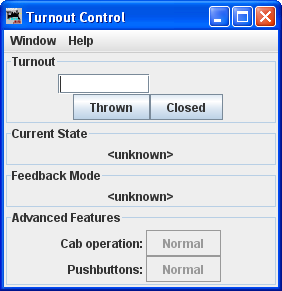DecoderPro® Main Window
Menu Bar - Turnout Control Panel

|
Turnout Control Turnout Enter the accessory number or tunout system name for the accessory or turnout you wish to control. For example, entering 678 and by pressing either the or buttons, you should be able to change the state of accessory number 678 on the layout. Another example, a valid turnout system name for NCE could be NT456. Then by pressing either the or buttons, you should be able to change the state of turnout or accessory number 456 on the layout Another example, a valid turnout name could be IT123 which is internal turnout number 123. Pressing either the or buttons will only change the state of the internal turnout and will not change a turnout on the layout. current state: A turnout can have four states: <unknown>, <inconsistent>, <thrown> and <closed> feedback mode: some of the available feedback modes are: <DIRECT>, <DELAYED>, <ONE SENSOR>, <TWO SENSOR>, and <MONITORING>. A turnout using DIRECT mode does not have feedback from the layout. When a close or throw command is executed the JMRI program assumes that the command always completes immediately. DELAYED simulates the turnout operation taking a few seconds to complete. ONE SENSOR use one sensor on the layout to provide feedback on he state of the turnout. TWO SENSOR uses two sensors for feedback, one for closed and one for thrown. MONITORING gets feedback from the system by either listening to cab commands on the layout or polling the system for turnout status. Caboperation: some turnouts can be locked. If the control button is grayed out, the lock feature is not available. Pushbuttons: Shows state of Pushbuttons. |